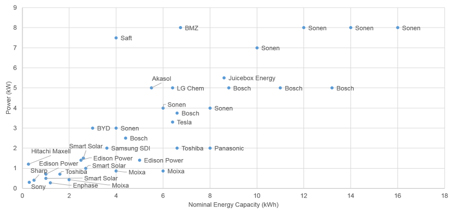



Feature Story
More feature stories by year:
2024
2023
2022
2021
2020
2019
2018
2017
2016
2015
2014
2013
2012
2011
2010
2009
2008
2007
2006
2005
2004
2003
2002
2001
2000
1999
1998
![]() Return to: 2016 Feature Stories
Return to: 2016 Feature Stories
CLIENT: IDTECHEX
November, 2016: North American Clean Energy
By Dr Xiaoxi He, IDTechEx
The phenomena of the shared economy has already changed many industries – to wit -- Airbnb and Uber. Energy storage, thus far immune from such models, may soon be dramatically affected.
Batteries which are commonly found in consumer electronics, are moving beyond this traditional sector and gravitating towards electric vehicles and energy storage systems (ESS). The emerging business models applying the "sharing" idea will force utilities to overcome the inertia of an unchanged structure and exert pressure for regulatory changes, which will help this industry achieve a $6 billion market value by 2026, as indicated in IDTechEx's brand-new report "Batteries for Residential, Commercial, Industrial and Utility Applications 2016-2026: Technologies, markets, players and opportunities"
Multiple consumer electronic players have recognized that consumers no longer want to change their mobile phones every two years This also means that the growth rate of consumer electronic batteries is plateauing.
In order to find new growth points, battery makers are exploring new business areas, especially electronics manufacturers such as AESC, Samsung, and Panasonic.
And automakers active in the residential, commercial, industrial and grid ESS businesses like Tesla, Daimler, Nissan, Toyota, and Honda are also entering the vehicle to home areas.
In essence, a cross-industry business is taking shape as evidenced by the large number of recent acquisitions, joint-ventures and investment deals. The market, accordingly, is fragmented with companies in various areas jumping in such as solar cell integrators, automotive players, cell makers, battery manufacturers, chemical suppliers, trading companies, power utilities, etc.

Figure 1 Comparison of current and future residential battery products in the market
With Tesla's Powerwall and Gigafactory bringing global attention to the market, residential or home batteries for behind-the-meter applications are gradually becoming accepted as backup power and as assets to store electricity for PV systems, allowing consumers the flexibility to buy and store electricity when rates are low, and consume it as needed.
Beyond residential systems, batteries are being used on a larger scale for a variety of commercial and industrial applications, and their use is being explored by utility companies, and even at the grid and utility levels. PJM, with the huge order of batteries, leads the US fast frequency regulation market. The National Grid Electricity Transmission's enhanced frequency response (frequency response at 1 second or less of registering a frequency deviation) tender is also a potential game changer.
Besides frequency services, battery storage can also offer other benefits such as energy capacity, investment deferral, transmission congestion relief, voltage control, load following, arbitrage, etc.
However, this is not a market-oriented industry yet. Government support plays an important role both in residential and grid applications. Two examples are Germany and California. Italian residential battery players, for instance, are pursuing the German market instead of the local market. In the C&I (commercial and industrial) sector, incentives and electricity pricing structure are important considerations. In California, many C&I entities use battery storage systems for demand charge reduction, which help them to save a significant amount of electricity charges.
For front-of-the-meter applications, the driver for supporting energy storage is often linked directly with renewable energy, particularly in areas of the grid with high penetrations of renewable generation. Pilot and demonstration projects take the majority.
For behind-the-meter applications, when the end-users already have a PV system, the differences between wholesale electricity rates and earning for selling electricity is vital, while for end-users without an existing PV system, the wholesale electricity rates are important.
We can find similarities between the history of the rapid uptake of solar PV and what is happening in the battery storage market, especially in the behind-the-meter sector. The opportunities and risks of battery storage boom are more complex compared with those of PV because of the multitude of applications and value streams involved, more safety concerns and their cumulative impact on the continued growth of rooftop solar. Based on historical data, the PV industry has experienced boom-bust cycles due to excess capacity caused by over-investment in this area. Battery storage may experience similar things if the investments exceed demand. Policies and regulations in various regions may impact the industry as well.
However, technology is not the major driver for current and future choices for battery solutions. The interests are largely stimulated by further battery cost reduction, especially lithium-ion batteries. At the same time, cost is also one of the major barriers for further large deployment. Therefore, how to use the same asset efficiently is an important consideration based on current prices.
It is widely accepted that a battery system used for a single application is not economic-based on current prices. However, it can be used for multiple applications to generate multiple value streams. Like Uber and Airbnb, these same assets can be utilized for owners and others --battery systems can be simultaneously shared by residential owners and utilities. Of course barriers and difficulties such as regulatory structures, lack of common codes and standards, and safety concerns are temporary hurdles that may be impeding growth. But we have seen companies applying the "sharing" idea already emerging in the energy industry. Those who can follow this emerging trend will seize the opportunity and win.
Dr. Xiaoxi He is a technology analyst for IDTechEx Research specialized in energy storage. She obtained her PhD from University of Cambridge and holds a Master's degree from Universität Ulm. Established in 1999, IDTechEx provides independent market research, business intelligence, and events on emerging technology to clients in over 80 countries. IDTechEx is headquartered in Cambridge UK; additional offices are in Berlin, Boston and Tokyo.
Return to: 2016 Feature Stories